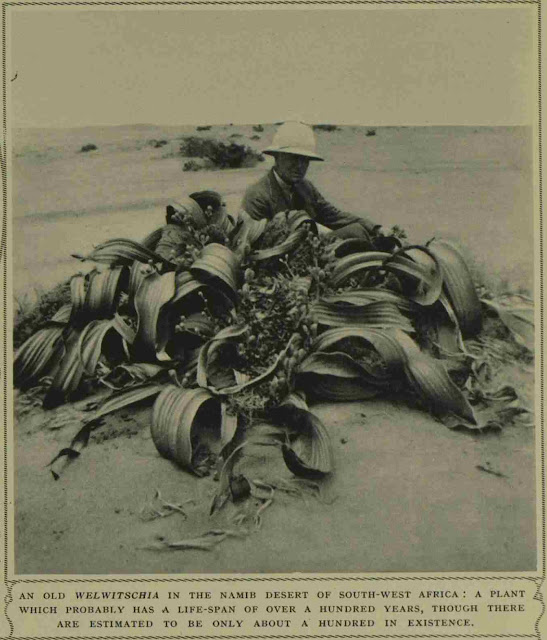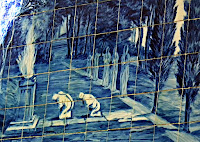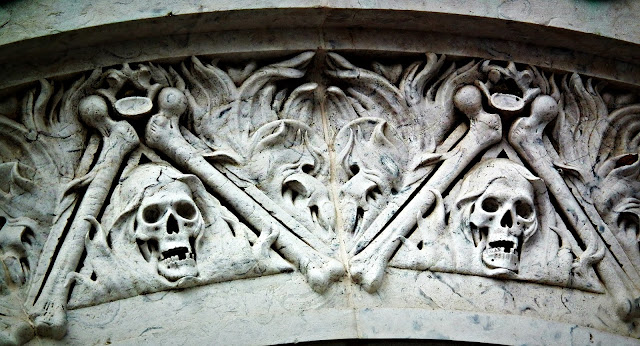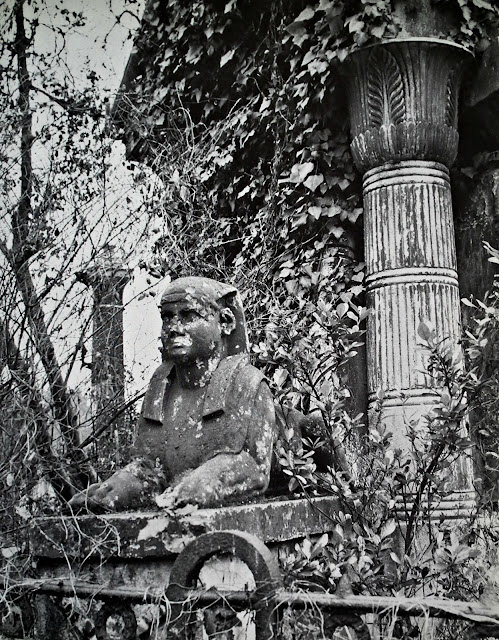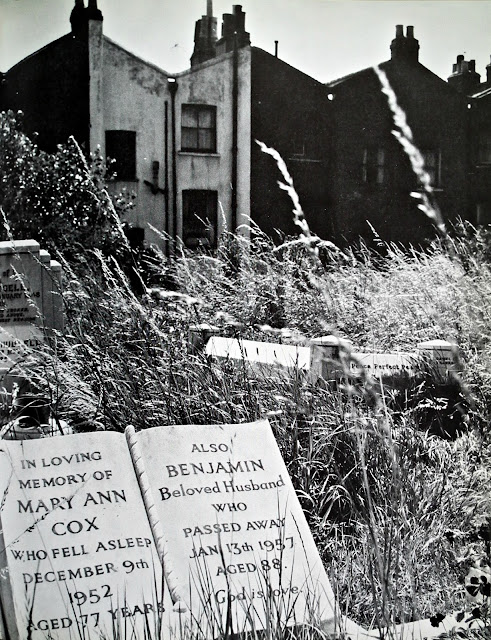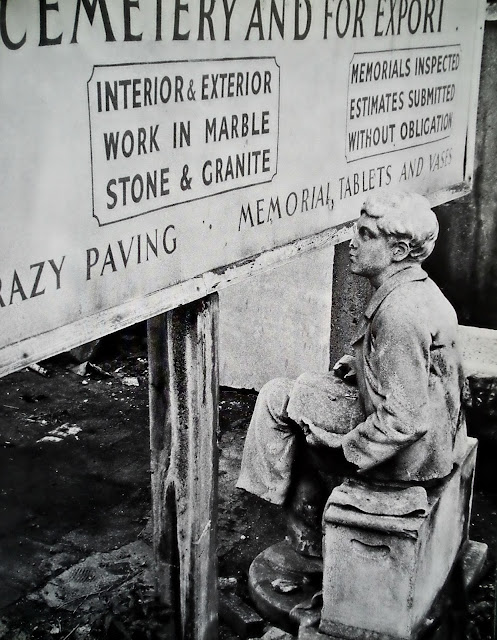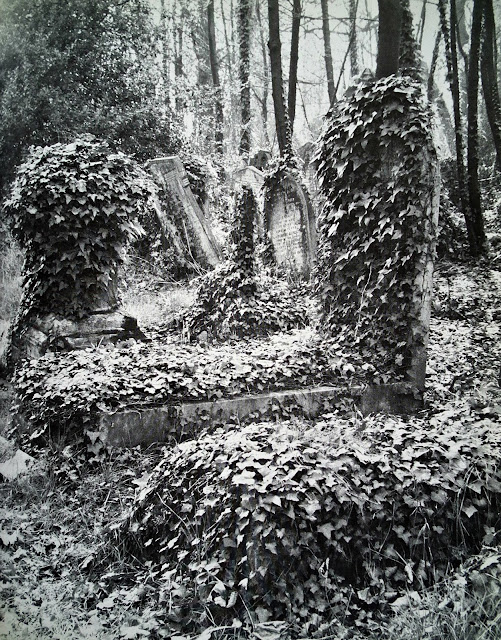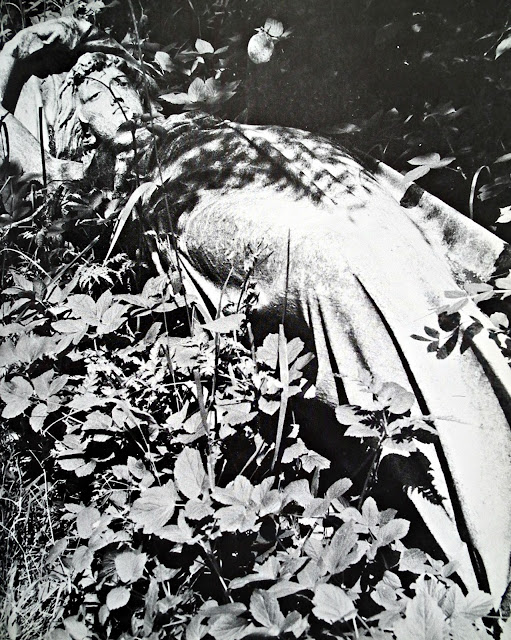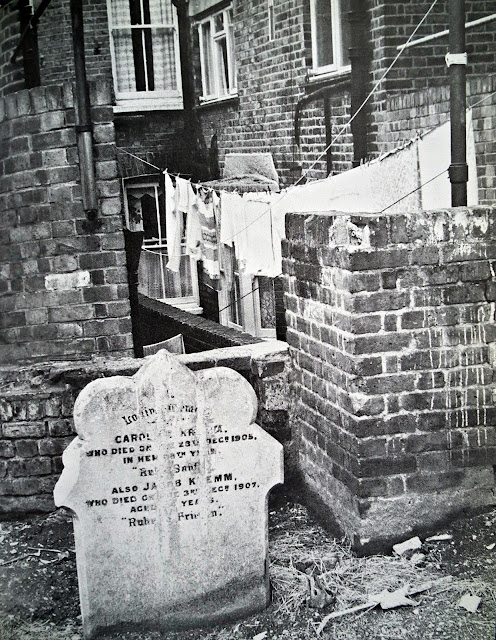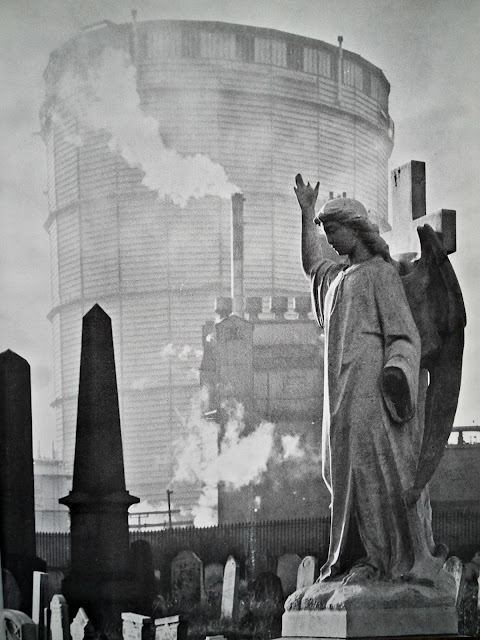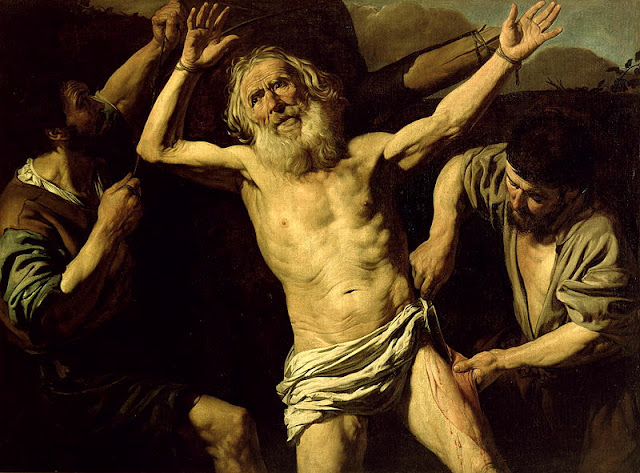Death of an
Eminent Botanist.—A remarkable man, Frederick Welwitsch, well known in
scientific, and especially botanical circles, died on Sunday afternoon, in
little lodging in Fitzroy Street, near Tottenham Court Road, London. The
deceased devoted his whole life to the flora of Africa. He was on the West
Coast of Africa for 18 years, in the service of the Portuguese, and was present
at the taking of Congo by them. He had collected, l am assured, forty thousand
specimens of African flora, and was at the time of his death engaged in a
"Magnum Opus" upon them. His lodging, which was almost entirely
filled with his specimens and books, so as hardly to admit of locomotion, was a
perfect sight. His best known work is on certain African molluscs.
Falkirk Herald - Thursday 24 October 1872
It
doesn’t matter how often I visit Kensal Green I always seem to be stumbling
across something new or unexpected, often in places I have walked past dozens
of times before. Just behind the main entrance on Harrow Road there is a gap
between the big memorials lining the verges, occupied by a relatively modest
memorial slab, which I often use to get off the path and explore the area
behind (which contains the distinctive red sandstone tomb of Daboda Dewanjee). Stepping across this conveniently low slab
for the umpteenth time I happened to glance down and found myself arrested in
mid stride by the name on the grave; Friedrich Welwitsch. Any doubts about his
identity were quickly dispelled by the Latin epitaph florae Angolensis investigatorum princeps. Much to my astonishment, because I had no idea
that he had any connection with London, I was looking at the final resting
place of the discoverer of that phantasmagorical plant of Namibia and the
southern Angolan desert, Welwitschia
mirabilis. Angolans, of which my wife is one, are inordinately proud of
their four national symbols, the Tchokwe sculpture known as O Pensador (the thinker) the Palanca
Negra (known as the Giant Sable
Antelope in the English speaking world), the Imbondeiro, the baobab tree, and Welwitschia, the improbable desert plant which has no English
name. Most Angolans are urban dwellers
and very few have seen the giant sable antelope or a baobab tree and even less
have had a reason to visit the almost uninhabited scorching deserts of the
south where they might see a Welwitschia.
In
most photographs Welwitschia mirabilis
is rather scraggy and unappealing looking and it is difficult to understand why
anyone would give it a second glance. Friedrich Welwitsch’s entranced reaction
on first sighting seems due to a touch of sunstroke; “I could do nothing,” he
later recollected “but kneel down and gaze at it, half in fear lest a touch
should prove it a figment of the imagination”. Welwitschia may be an odd looking plant but its discoverer seems to
be overreacting. If you see a photo of the plant with a human being or, even
better for a large specimen, a four by four in it to give some idea the scale
you start to begin to get some idea of how impressively bizarre it is. In a
desert with virtually no plant life, no trees, few shrubs, little grass, barely
even any cacti, the sight of a writhing monstrosity just one and a half metres
high but almost 45 metres in circumference must be truly startling. Welwitschia is a living fossil that has
somehow managed to survive on a peripheral outpost of Gondwanaland whilst all
its contemporaries died out sometime in the Triassic. Individual plants can be
astonishingly ancient, many specimens would have germinated at the time of the
Norman Conquest and be due to celebrate their 1000th birthday in the next few
years and the oldest may well have been around since the time of Christ. The
untidy cluster of shredded leaves is deceptive, Welwitschia has only two leaves growing from a woody tap root that
reaches four or five metres in length, anchoring it almost immovably in the
friable desert soil. The plant seems to have a mass of leaves because the two
it has shred lengthwise in the harsh desert climate. The leaves are never shed,
they continue to grow for the entire life of the plant. The reason that it is
unusual for the leaves to reach more than four metres in length is that the
ever moving tips are abraded by the stony ground or nibbled at by iron toothed
herbivores. The Namibe desert has almost
zero rainfall and Welwitschia survives
on the coastal fogs that roll in most mornings from the Atlantic and are formed
when the deep, cold Benguela current meets warm shallow tropical waters. The Namibe desert is an almost unique
environment, nowhere else on earth will you see penguins rubbing shoulders with
hyenas, and the only other place on earth a transplanted Welwitschia
might survive would be in the Atacama in South America.
| Proof that Welwitschia is not carnivorous (photo courtesy of lusodinos blogspot) |
Friedrich
Welwitsch was born in the southern Austrian region of Carinthia in 1807 into
the large family of a prosperous farmer and surveyor who wanted his son to
become a lawyer. Welwitsch had other
ideas having been a keen amateur naturalist since his childhood and the
resulting conflict between him and his father led to stopping of his allowance
and Welwitsch switching from the law to
medicine for his degree in Vienna. He
did eventually make up with his father, after he had qualified as a physician,
but during his studies he supported himself by writing theatre reviews and
tutoring a nobleman’s son. He also continued with his botanical studies at the
Vienna Museum and began to look for opportunities to travel. One came, in a
timely fashion according to an early memoir of the naturalist, when “an act of
youthful indiscretion on his part, in the course of enjoying too freely the
gaieties of Vienna, rendered it expedient for him to leave Austria for a time”,
(his act of ‘youthful indiscretion’ was committed at the early age of 33). The opportunity came via the Unio Itineraria
of Wurtemburg, a learned society who sold shares in an expedition to the Azores
and Cape Verde Islands amongst their members at 24 florins each, each
shareholder being entitled to part of the specimens collected by Welwitsch. It
was a fateful opportunity, not only did Welwitsch make his lusophone
connections on this trip he also travelled via London and made the acquaintance
of the eminent botanist Robert Brown (also buried at Kensal Green a mere
stone’s throw away from Welwitsch).
Freidrich learned Portuguese in six weeks and so impressed his hosts
that he was offered a job looking after Lisbon’s Botanical Gardens. After
thoroughly studying the flora of the Alentejo and Algarve under the aegis of
the Portuguese government he travelled to Angola in 1853, stopping at Madeira,
Cabo Verde and Sierra Leone en route. He spent almost seven years in Angola,
initially in Luanda, exploring the coast and interior, before moving on to
jungles of Golungo Alto on the river Bengo where me met and lived with David
Livingstone for a couple of months. He later travelled to the south of the
country to Benguela on the coast and Mossamedes in the interior. It was here
that he discovered Welwitschia. He only returned to Lisbon in 1860 when a
native uprising of 1500 Ovimbundu left him trapped for two months in a
settlement near Huila. In 1863 the Portuguese Government gave him permission to
take his Angolan specimens to London, to consult with scientists who would help
with the work of identifying and classifying the collection. Once in London and
absorbed in his work he paid little heed to the increasingly insistent requests
of Portuguese officials for news on how the work was going. In 1866 his Portuguese
salary was stopped and Friedrich had to resort to selling duplicates from the
collection to pay his living expenses. This caused further fury in Portugal
where he was denounced in Parliament for selling off the Royal collections and
“living in splendour on the proceeds.” A fire at his lodgings at 15 Fitzroy
Street (just a ten minute walk from the British Museum) in the summer of 1872
did not damage his specimens but seems to have shaken him. His health rapidly
deteriorated and he died in his lodgings on the evening of 20th October 1872,
leaving a complicated will written just three days previously.
In
his will Welwitsch bequeathed his collections to a variety of institutions,
something that was bound to cause trouble when the Portuguese government felt
that they were the rightful owners. His first instruction was “my study copy of
African plants to be offered to the British Museum at the rate of E2 10s. per
century (100 species) subject to one set of Mosses being first selected
thereout and given to Mons. Duby of Geneva.” Two sets were then to go free to
the Portuguese Government, others to various herbaria including the Museum at
Carinthia, the Imperial Natural History Museum at Rio de Janeiro, the English
Government for the use of Kew Gardens, and to the Botanical Museums of Paris,
Berlin, Vienna, and Copenhagen and finally he bequeathed his general herbarium
and Portuguese herbarium at Lisbon to the Royal Academy of Sciences at Lisbon. Almost
as soon as the will went through probate the Portuguese Government, in the name
of King Luis I, started proceedings in Chancery try and wrest what they viewed
as their collection from the other legatees of Welwitsch’s will. The resulting
court battles took almost 3 years to settle.
On the 18th November 1875 the London Evening Standard was
able to report that a compromise between the litigant, the King of Portugal,
and the executors of Welwitsch’s will
had finally been reached after the court decided “that the King was entitled to
all the African collections; that he, as an act of grace and favour, should pay
to the defendants £700, in full settlement of all demands; that the study set,
next best set, be separated from the general collection by Drs. Hooker and Hiern;
that the British Museum should retain the second best set as a gift from the
King; that the defendants should hand over all the rest, of the collections to him;
and that the King should distribute the collections according to the will as an
act of grace and favour.” The best set
went of course to Lisbon but the British Museum did not have to pay the £2 10s
per 100 specimens stipulated in the will.
 |
| Welwitsch probate record |
When
my wife was growing up in Benguela she and her primary school classmates were
convinced that Welwitschia was
carnivorous, why else would anyone make a huge fuss about such an ugly plant? They
imagined a single length of leaf as tough as nylon cord, snaking out from the
main body of the plant, creeping stealthily along the ground and soundlessly winding
itself around the ankle of a stray goat before hauling its bleating and
furiously struggling prey back to a hidden maw in the mass of leaves. Or maybe a
tightly coiled stalk would whip out to lasso a careless tribesman or foolish
white explorer around the neck and then drag its choking victim along the dusty
ground to be sucked dry. Angolans are great story tellers, as people living in
the grimmest situations often are. Rumour, exaggeration, gossip, boasting and
speculation transform even the most inconsequential incidents into flamboyant
narratives. As a result no one believes a word anyone else says if it sounds
even slightly out of the ordinary. When the country became independent in 1975
almost half a million white Portuguese hurriedly left Angola, many returning to
live in poverty in Portugal where they found themselves discriminated against
as retornados. Black Angolans started
to flee the country shortly after the colonists when independence degenerated
into a prolonged and bloody civil war.
 |
| Namibe, Angola by Joost De Raeymaeker |
My
wife’s family left in the early 1980’s when the civil war was at its height.
The Portuguese were never especially welcoming to displaced Angolans of any
colour and the white retornados often
found they had more in common with the black refugees than they did with their
supposed countrymen. My wife’s family settled in a small village outside Lisbon
where they found themselves latched onto by a lonely middle-aged white woman
who had been born in Luanda. She had been brought up, she said, in colonial
splendour on a large coffee growing estate. Tia Maria, as they called her, missed
Africa and wanted to endlessly talk about her life there. There was a lot of
scepticism amongst her listeners about some of her stories. She claimed, for
example, that the family was so beloved by the workers on the estate that they
were surrounded by dozens of weeping Africans when they left to return to
Portugal in 1975. One of them was apparently so distraught at losing them that
he followed them to Luanda and to the airport where, in the confusion and chaos
as thousands of people fought to get on flights to Lisbon and Porto, he managed
to sneak onto the runway and hide in the wheel well of the aircraft taking the
family home by climbing the landing gear. He remained tucked away behind the
retracted wheel during the 8 hour, 3500 mile flight from Angola to Portugal. As
the plane began its descent towards Portela airport in Lisbon the crew extended
the landing gear, dislodging the unfortunate stowaway, who fell several
thousand feet and was killed instantly. The Angolan refugees listening to this
story snorted with disbelief; firstly, why would any black Angolan want to
follow his white mistress back to Portugal? The idea was simply ludicrous. And
secondly, even an idiot would know that it is not possible to stowaway beneath
a jet plane and survive a journey in the upper atmosphere where there is no
oxygen to breath and the temperature plummets to 50 or 60 degrees below
freezing. When my wife told me the story I agreed with her – it was ridiculous,
attempting to hitch a free plane ride in such a perilous way was unheard of.
After
dismissing the story we were astonished by the news in October 1996 that two brothers
from New Delhi had stowed away in the wheel well of a British Airways 747 on a
flight from New Delhi to Heathrow and one of them actually managed to survive
the flight. And then just a few months later, in March 1997, a 13 year old
Kenyan boy was found crushed by the landing gear on a flight arriving at
Heathrow from Nairobi. The following year a dead Azerbaijani fell out of the wheel
well of a British Airways flight from Baku when it landed at Gatwick. In the
following years there were more stories of planes landing with bodies in the
wheel well or of bodies falling from the sky as planes readied to land at
airports. Tia Maria’s story did not sound quite so far fetched any more,
especially when on a quiet Sunday morning in September 2012 British Airways
flight BA76 from Luanda flew over a deserted Portman Avenue in Mortlake at 7.42am.
Seconds later several residents of the suburban street were awoken by a loud
thud but when they looked out of their windows there was nothing unusual to see.
A few minutes later two boys on their way to church found an African man
dressed in jeans, white trainers and a grey hoodie lying dead on the pavement.
The police were called and initially suspected that the injuries sustained by
the unknown man were caused by a beating with baseball bats. But when a search
of the victim’s pockets showed that the only money he had on him were Angolan
Kwanzas and several witnesses came forward to say they had heard a loud noise
at a time that coincided with the time that the BA flight from Luanda passed
overhead, it began to seem more likely that the man was a stowaway. The victim
had no identification documents on him; the only clues to his identity were a tattoo
on his left arm with the letters Z and G and an e-fit reconstructed from the
remains of his battered face. The police hoped this would be enough for someone
in the British Angolan community to recognise him. It took police almost seven
months to identify him. In April 2013 they announced that the victim was José
Matada, believed to be from Mozambique, not Angola; ironically his 26th
birthday was on the 9th September, the day he had fallen from the
sky above Mortlake to his death in Portman Avenue. The Police had eventually
identified him via an Angolan Movicel SIM card retrieved from the smashed
mobile phone found in his pocket. This revealed a string of text messages
between him and a woman who was eventually traced to Switzerland. When the
police talked to her about the texts she was able to identify José, even
describing the tattoo on his arm. He had worked for the woman’s family as a
gardener and housekeeper in South Africa. When the family moved away José sent
her a stream of texts talking about going to Europe to make a better life for
himself presumably hoping she would help or offer him employment. He moved to
Angola from South Africa for reasons that have never become clear and made his
final, desperate attempt to get to Europe from Quatro de Fevereiro Internation
Airport in Luanda on the evening of Saturday 8th September. The pathologist
giving evidence at his inquest said that José would have been close to death,
possibly even already frozen and suffocated to death, by the time the BA Boeing
777 slowed to 240mph and dropped altitude to 2500 feet on its final descent to
Heathrow and he fell from the wheel well to the pavement of Portman Avenue,
SW14. The efforts of the authorities in Mozambique to identify José’s family
initially ended in failure but then in January 2014 they finally came forward
after seeing his story in the newspaper Verdade.
José’s body had been marked in an unmarked grave in Twickenham; his family
could not afford the $11,500 it would cost to repatriate him back home.
 |
| E-fit of Jose Matada issued by the Police |

